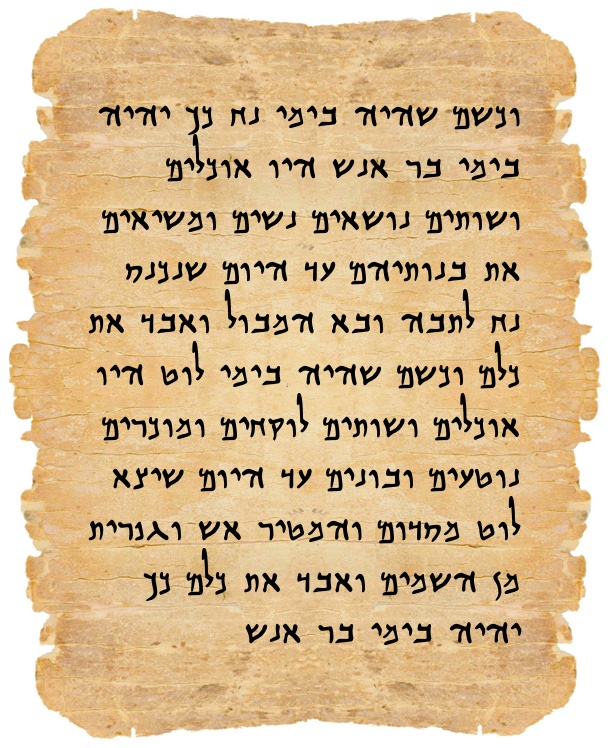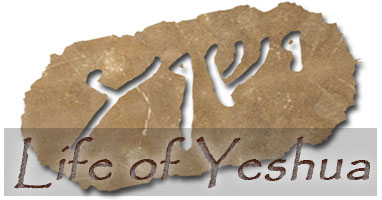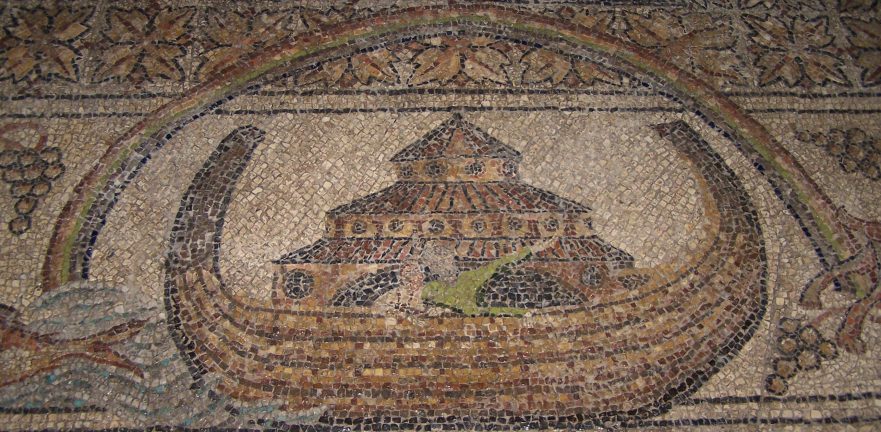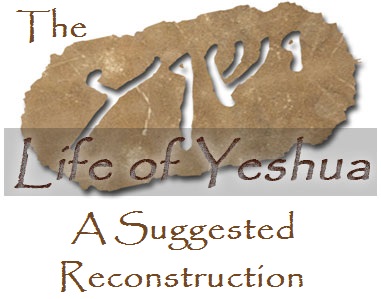(Matt. 24:37-39; Luke 17:26-30)
(Huck 184, 224; Aland 235, 296; Crook 285, 335)[88]
Updated: 29 November 2024
וּכְשֵׁם שֶׁהָיָה בִּימֵי נֹחַ כָּךְ יִהְיֶה בִּימֵי בַּר אֱנָשׁ הָיוּ אוֹכְלִים וְשׁוֹתִים נוֹשְׂאִים נָשִׁים וּמַשִּׂיאִים אֶת בְּנוֹתֵיהֶם עַד הַיּוֹם שֶׁנִּכְנַס נֹחַ לַתֵּבָה וּבָא הַמַּבּוּל וְאִבַּד אֶת כֻּלָם וּכְשֵׁם שֶׁהָיָה בִּימֵי לוֹט הָיוּ אוֹכְלִים וְשׁוֹתִים לוֹקְחִים וּמוֹכְרִים נוֹטְעִים וּבוֹנִים עַד הַיּוֹם שֶׁיָּצָא לוֹט מִסְּדוֹם וְהִמְטִיר אֵשׁ וְגָפְרִית מִן הַשָּׁמַיִם וְאִבַּד אֶת כֻּלָם כָּךְ יִהְיֶה בִּימֵי בַּר אֱנָשׁ
“The way it happened in the days of Noah will be how it happens in the days of the Son of Man: they carried on eating and drinking, contracting and arranging marriages until the day Noah embarked on the ark and the flood came and killed them all.
“And the way it happened in the days of Lot—when they carried on eating and drinking, buying and selling, planting and building until the day Lot departed from Sodom and God rained down fire and sulfur from the sky and killed them all—that’s how it will happen in the days of the Son of Man.[89]
| Table of Contents |
|
2. Conjectured Stages of Transmission 5. Comment 8. Conclusion |

.
Reconstruction
To view the reconstructed text of Days of the Son of Man click on the link below:
Premium Members and Friends of JP must be signed in to view this content.
If you are not a Premium Member or Friend, please consider registering. Prices start at $5/month if paid annually, with other options for monthly and quarterly and more: Sign Up For Premium
Conclusion
In Days of the Son of Man Jesus expressed his deep pessimism that his serving as a sign of doom to his generation would succeed in convincing them to repent. Jesus realized that instead of repenting of dangerous religious and political ideologies and embracing the redemption Jesus offered to them, the majority of his contemporaries would ignore his message and carry on with business as usual. Communicating his message in apocalyptic images, Jesus warned his contemporaries that ignoring the dangerous trends in first-century Jewish society would only allow those trends to gain momentum, until finally the clash with the Roman Empire—and the dire consequences that confrontation would bring—could no longer be averted.
 Click here to return to The Life of Yeshua: A Suggested Reconstruction main page.
_______________________________________________________
Click here to return to The Life of Yeshua: A Suggested Reconstruction main page.
_______________________________________________________
- [1] Although in the published form of Flusser’s Hebrew retroversion of Days of the Son of Man we read כימי, it is clear that כימי is a typographical error and that Flusser intended to write בימי. ↩
- [2] See David Flusser, “The Literary Relationship Between the Three Gospels,” in his Jewish Sources in Early Christianity: Studies and Essays (Tel Aviv: Sifriat Poalim, 1979 [Hebrew]), 28-49, esp. 46. The English translation of Flusser’s retroversion is our own. ↩
- [3] For the precise figures, see LOY Excursus: Criteria for Distinguishing Type 1 from Type 2 Double Tradition Pericopae. ↩
- [4] On the derivation of Luke’s John the Baptist block from Anth., see the introduction to the “Yohanan the Immerser and the Kingdom of Heaven” complex. ↩
- [5] On the derivation of the block of missions material in Luke 10:1-24 from Anth., see Woes on Three Villages, under the subheading “Story Placement.” ↩
- [6] On the prayer block in Luke 11:1-13, see the introduction to the “How to Pray” complex. ↩
- [7] See Persistent Widow, under the “Story Placement” subheading. ↩
- [8] See Persistent Widow, Comment to L27-28. ↩
- [9] Lindsey (JRL, 229-230; TJS, 70-71) suggested that The Kingdom Is Among You (Luke 17:20-21) is the First Reconstructor’s paraphrase of Like Lightning (Luke 17:22-24), but this suggestion is untenable given that Luke 21:8-9 is more likely to be FR’s version of Luke 17:22-24. Moreover, The Kingdom Is Among You is not really a parallel to Like Lightning; The Kingdom Is Among You concerns the Kingdom of God and asserts that no one will say, “Here it is!” or “There it is!” whereas Like Lightning concerns the Son of Man and asserts that people will (falsely) say, “There he is!” and “Here he is!” In other words, the two pericopae deal with different phenomena that provoke opposite reactions. Rather than explaining these two pericopae as doublets, it is more likely that these two originally unrelated sayings were brought together on the basis of the catchwords “here” and “there” contained in both pericopae. The question, then, is whether these two pericopae were already associated with one another in Anth. or whether their collocation is due to the author of Luke. We suspect that the collocation is Lukan, since The Kingdom Is Among You is written in a more polished Greek style than is usual for Anth. Regardless of its origin, The Kingdom Is Among You is a deeply problematic pericope, since its contention that the Kingdom of God cannot be detected by the senses flatly contradicts Jesus’ insistence in Finger of God that his expulsion of demons is empirical evidence that “the Kingdom of God/Heaven has come upon you” (Matt. 12:28 ∥ Luke 11:20). ↩
- [10] See Burnett H. Streeter, “On the Original Order of Q,” in Studies in the Synoptic Problem (ed. W. Sanday; Oxford: Clarendon, 1911), 141-164, esp. 150-151. ↩
- [11] On the First Reconstructor’s blending of two or more originally distinct prophecies to produce Jesus’ eschatological discourse, see Robert L. Lindsey, “From Luke to Mark to Matthew: A Discussion of the Sources of Markan ‘Pick-ups’ and the Use of a Basic Non-canonical Source by All the Synoptists,” under the subheading “An Examination of the Editorial Activity of the First Reconstructor”; idem, JRL, 66-71; idem, TJS, 72-75. See also our introduction to the “Destruction and Redemption” complex. ↩
- [12] Cf. Knox, 2:107; Kloppenborg, 154; Davies-Allison, 3:375. ↩
- [13] Cf. Nolland, Luke, 2:856. ↩
- [14] On Jesus’ role as a sign of doom to his generation, see Sign-Seeking Generation, Comment to L39. ↩
- [15] Apocalyptic literature uses fantastic imagery (e.g., composite beasts with multiple appendages) and scriptural motifs (e.g., Noah’s flood, the overthrow of Sodom and Gomorrah) to portray traumatic events (current or anticipated) and the social upheaval such events generate. The authors of apocalyptic literature used this imagery to provide their religious and political commentary on these events in a way that could be understood by “insiders” but that would be opaque to the entities they criticized. ↩
- [16] Guenther correctly observed that the block of Son of Man material preserved in Luke 17 “does not speak explicitly of the Son of Man delivering the final verdict at the end of time.” See Heinz O. Guenther, “When ‘Eagles’ Draw Together,” Forum 5.2 (1989): 140-150, esp. 140-141. ↩
- [17] Jeremias (Theology, 127-128) drew a connection between Days of the Son of Man and Calamities in Yerushalayim, one of the pericopae we have included in the “Choose Repentance or Destruction” complex, writing: “Horrors will descend upon them...as astounding as the flood, the rain of fire on Sodom.... Streams of blood will flow. Pilate’s bloodbath among the Galileans and the collapse of the Tower of Shiloah (Luke 13.1-5) will seem as child’s play in comparison to what will break out over Israel.” ↩
- [18] On the First Reconstructor’s insertion of this prophecy into the eschatological discourse, see the introduction to the “Destruction and Redemption” complex and the LOY segment entitled Completion, under the subheading “Conjectured Stages of Transmission.” ↩
- [19] On our dating of the composition of Luke’s Gospel, see LOY Excursus: The Dates of the Synoptic Gospels. ↩
- [20] On our post-70 C.E. dating of the composition of Mark’s Gospel, see LOY Excursus: The Dates of the Synoptic Gospels. ↩
- [21] The use of the absolute titles “the Father” and “the Son” for God and Jesus, respectively, appears to have been inspired by the Father and Son saying preserved in Matt. 11:27 ∥ Luke 10:22. There, however, “the father” and “the son” are best understood not as titles but as general nouns with definite form (i.e., “a father,” “any father”; “a son,” “any son”). See Jeremias, Prayers, 47; Lindsey, JRL, 31-32. ↩
- [22] FR “strings of pearls” are found in Luke 8:16-18; 9:23-27; 16:16-18; 17:1-6. See LOY Excursus: Sources of the “Strings of Pearls” in Luke’s Gospel. ↩
- [23] The Anth. doublet of Luke 9:26 in Luke 12:8-9 ∥ Matt. 10:32-33 does not use the absolute title “the Father” to refer to God. Matt. 10:32-33 has “my father in heaven,” while Luke 12:8-9 has “the angels of God.” ↩
- [24] See Foakes Jackson-Lake, 4:8; Haenchen, 143. ↩
- [25] The similarity between Mark 13:32 and Acts 1:7 would be increased if, instead of οὐχ ὑμῶν ἐστιν γνῶναι (“it is not yours to know”), the original text of Acts 1:7 was οὐδεὶς δύναται γνῶναι (“no one is able to know”). On this reading, see Foakes Jackson-Lake, 3:5; 4:8. ↩
- [26] See Robert L. Lindsey, “A New Two-source Solution to the Synoptic Problem,” under point 2; idem, “Introduction to A Hebrew Translation of the Gospel of Mark,” under the subheading “The Confirmation of Lockton’s Work.” ↩
- [27] Lindsey believed that a substantial portion of the author of Mark’s redactional activity involved working vocabulary, associations and ideas gleaned from Acts into his retelling of the stories and sayings of Jesus. See Robert L. Lindsey, “Introduction to A Hebrew Translation of the Gospel of Mark,” under the subheading “Sources of the Markan Pick-ups”; idem, HTGM, 54-55. See also LOY Excursus: Catalog of Markan Stereotypes and Possible Markan Pick-ups. ↩
- [28] Cf. Nolland, Luke, 2:859. ↩
- [29] Cf. Harnack, 106. ↩
- [30] See Schweizer, 460. ↩
- [31] The LXX translators frequently rendered בִּימֵי + proper noun as ἐν ἡμέραις + proper noun (Judg. 5:6; 8:28; 1 Chr. 4:41; 5:10, 17; 7:2; 2 Chr. 9:20; 2 Esd. 4:7; 22:7, 12, 22, 26, 46, 47; Hos. 1:1; Amos 1:1; Mic. 1:1; Zeph. 1:1; Zech. 14:5). The omission of the definite article before ἡμέραις reflects the lack of definite articles in the first component of Hebrew construct phrases. ↩
- [32] Examples of ἐν ταῖς ἡμέραις + proper noun occurring as the translation of בִּימֵי + proper noun are found in the following verses:
2 Kgdms. 21:1 ἐν ταῖς ἡμέραις Δαυιδ = בִּימֵי דָוִד
3 Kgdms. 10:21 ἐν ταῖς ἡμέραις Σαλωμων = בִּימֵי שְׁלֹמֹה
4 Kgdms. 15:29 ἐν ταῖς ἡμέραις Φακεε = בִּימֵי פֶּקַח
2 Chr. 26:5 ἐν ταῖς ἡμέραις Ζαχαριου = בִּימֵי זְכַרְיָהוּ
2 Chr. 32:26 ἐν ταῖς ἡμέραις Εζεκιου = בִּימֵי יְחִזְקִיָּהוּ
Esth. 1:1 ἐν ταῖς ἡμέραις Ἀρταξέρξου = בִּימֵי אֲחַשְׁוֵרוֹשׁ
Isa. 7:1 ἐν ταῖς ἡμέραις Αχαζ = בִּימֵי אָחָז
Jer. 1:2; 3:6 ἐν ταῖς ἡμέραις Ιωσια = בִּימֵי יֹאשִׁיָּהוּ
Jer. 1:3 ἐν ταῖς ἡμέραις Ιωακιμ = בִּימֵי יְהוֹיָקִים
Jer. 33:18 ἐν ταῖς ἡμέραις Εζεκιου = בִּימֵי חִזְקִיָּהוּ
- [33] See Hatch-Redpath, 3:121-122. ↩
- [34] Instances of the name Νῶε in the writings of Philo occur in Leg. 2:60; 3:77; Det. §105, 121; Post. §48, 173, 174; Gig. §1, 3, 5; and elsewhere. ↩
- [35] The name Νῶχος occurs in Apion 1:130, 131; Ant. 1:74, 76, 78, 80, 87, 90, 91, 96, 99, 104, 109, 113, 122 (2xx), 129, 140, 142, 143, 148; 3:87; 20:25. ↩
- [36] In Matthew παρουσία occurs 4xx (Matt. 24:3, 27, 37, 39). ↩
- [37] Pace Harnack, 106. See Marshall, 664; Catchpole, 249; Bovon, 2:519. ↩
- [38] Cf. Sign-Seeking Generation, Comment to L42-43. ↩
- [39] See Luz, 3:211. ↩
- [40] See Catchpole, 249. Cf. Nolland, Luke, 2:860; Hagner, 2:718. ↩
- [41] Pace Nolland, Luke, 2:860. ↩
- [42] Pace Gundry, Matt., 493; Davies-Allison, 3:381. ↩
- [43] See LSJ, 1832; McNeile, 356. ↩
- [44] On traditions concerning antediluvian vegetarianism, see Ginzberg, 1:151. The hypothesis that Matthew’s choice of τρώγειν alludes to antediluvian vegetarianism is, in any case, more plausible than that the author of Matthew wished to emphasize the sound of people’s crunching (cf., e.g., Nolland, Matt., 993; France, Matt., 931 n. 4). ↩
- [45] See Sjef van Tilborg, “The meaning of the word γαμῶ in Lk 14:20; 17:27; Mk 12:25 and in a number of early Jewish and Christian authors,” HTS Teologiese Studies 58.2 (2002): 802-810. ↩
- [46] See Wolter, 2:309. ↩
- [47] See Jastrow, 937-938. ↩
- [48] Additional examples of הִשִּׂיא אֶת בִּתּוֹ occur in m. Ket. 6:5; m. Ned. 5:6; 11:10. ↩
- [49] See Hatch-Redpath, 1:188. ↩
- [50] Cf. McNeile, 356. ↩
- [51] See Hatch-Redpath, 2:763-764. ↩
- [52] See Even-Shoshan, Concordance, 1218. ↩
- [53] Cf. Marshall, 662; Catchpole, 249; Hagner, 2:718; Nolland, Matt., 993. ↩
- [54] See Hatch-Redpath, 2:734. ↩
- [55] See Dos Santos, 103. ↩
- [56] Cf. Nolland, Luke, 2:860, and contrast with Nolland, Matt., 993. ↩
- [57] On reconstructing ἀπολλύειν with אָבַד, see Calamities in Yerushalayim, Comment to L13. ↩
- [58] On the construction of the ark and its loading with provisions and passengers as an inducement to repentance, see Philo, Q.G. 2:13. ↩
- [59] On Noah’s verbal exhortations, see 2 Pet. 2:5; Jos., Ant. 1:74; 1 Clem. 7:6. See also Ginzberg, 1:140 n. 19. ↩
- [60] There are sources from the Second Temple period that identified Enoch as a sign to all generations (Jub. 4:22-24; Sir. 44:16). However, Flusser noted that a certain fluidity existed between traditions concerning Noah and Enoch. See David Flusser, “Jesus and the Sign of the Son of Man” (Flusser, JOC, 526-534, esp. 529). ↩
- [61] See Bundy, 389 §298; Schweizer, 459; Heinz O. Guenther, “A Fair Face Is Half the Portion: The Lot Saying in Luke 17:28-29,” Forum 6.1 (1990): 56-66; Steven L. Bridge, ‘Where the Eagles are Gathered’: The Deliverance of the Elect in Lukan Eschatology (Sheffield: Sheffield Academic Press, 2003), 42-43. ↩
- [62] See Streeter, “On the Original Order of Q,” 150; Manson, Sayings, 143; Marshall, 662; Gundry, Matt., 493; Catchpole, 248; Nolland, Luke, 2:856-857, 860; Hagner, 2:718; Luz, 3:211. ↩
- [63] See Kloppenborg, 157-158. ↩
- [64] The stories of Noah and Lot are associated in Jub. 20:5; Sir. 16:7-8; Philo, Mos. 2:52-65; 2 Pet. 2:4-8; Jude 6-7; t. Taan. 2:13; Gen. Rab. 27:3. In some of these examples Noah is not explicitly mentioned, but reference is made to the angels who sinned with human women in the days of Noah; in others, Lot is not explicitly mentioned, but reference is made to the destruction of Sodom and Gomorrah. Josephus (J.W. 5:566) mentioned the flood and Sodom’s overthrow together with the earth's swallowing up Korah and his associates. The Mishnah lumped the generation of the flood together with the generation of the dispersion (i.e., those who built the tower of Babel and were dispersed) and the men of Sodom as notorious Gentile populations that have no share in the world to come (m. Sanh. 10:3; cf. t. Sanh. 13:6-8). Mechilta de-Rabbi Ishmael (Shirata §5 [ed. Lauterbach, 194]) similarly lumps together the generation of Noah, the generation of the dispersion and the people of Sodom. ↩
- [65] Cf. Marshall, 664. ↩
- [66] On ὁμοίως as an indicator of Lukan redaction, see Calamities in Yerushalayim, Comment to L13. ↩
- [67] See Hatch-Redpath, 3:102. ↩
- [68] Instances of the name Λώτ in the works of Philo can be found in Leg. 3:213; Post. §175, 177; Ebr. §164; and elsewhere. ↩
- [69] The name Λῶτος occurs in Ant. 1:151, 154, 169 (2xx), 170, 175, 176, 179, 200 (2xx), 201, 202 (2xx), 203, 206. ↩
- [70] See Hatch-Redpath, 2:1446-1447. ↩
- [71] See Dos Santos, 132. ↩
- [72] See Plummer, Luke, 408. ↩
- [73] Cf., e.g., καὶ ἐξῆλθεν εὐθὺς αἷμα καὶ ὕδωρ (“and came out [sing.] immediately blood and water”; John 19:34). ↩
- [74] See Hatch-Redpath, 1:230. ↩
- [75] See Dos Santos, 110. ↩
- [76] Using “Heaven” as a substitute for the Tetragrammaton in L29 would have been awkward, since in that case Jesus would have had to say, “and Heaven caused fire and sulfur to rain from heaven.” ↩
- [77] See Hatch-Redpath, 1:628. ↩
- [78] See Dos Santos, 38. ↩
- [79] The order גָּפְרִית→אֵשׁ does, however, occur in Ezek. 38:22; Ps. 11:6. ↩
- [80] On Jub. 16:5, see James C. VanderKam, Jubilees 1: A Commentary on the Book of Jubilees Chapters 1-21 (Minneapolis: Fortress, 2018), 533-534. ↩
- [81] Do the instances of fire→sulfur in Jub. 16:5, Luke 17:29 and t. Taan. 2:13 attest to a pre-Masoretic version of Gen. 19:24 that mentioned fire before sulfur? ↩
- [82] As we discussed in Comment to L27, the author of Luke attempted to compensate for the asymmetry of comparing “the days of Lot” to “the day in which the Son of Man is revealed” by writing “in the day in which Lot exited Sodom” (L27-28). He thereby attempted to shift the point of comparison from the way people are able to be blissfully unaware of imminent peril to the day on which calamity will strike. But by opening the comparison with “just as it was in the days of Lot” (L22-23) the author of Luke failed to cover his tracks, and the result is a lopsided comparison. ↩
- [83] On Lot’s righteousness and distress at the wickedness of Sodom, see Wis. 10:6; 19:17; Philo, Mos. 2:58; 2 Pet. 2:7-8; t. Sanh. 14:4. According to a baraita in b. Ber. 54b, two blessings were to be recited by anyone who came across the pillar of salt into which Lot’s wife had been transformed. The first blessing refers to the fate of Lot’s wife, while the second blessing refers to Lot’s deliverance: ברוך זוכר את הצדיקים (“Blessed is the One who remembers the righteous ones”). This blessing may be another witness to the tradition of Lot’s righteousness. It is possible, however, that the blessing refers not to Lot’s righteousness but to Abraham’s, for commenting on this blessing Rabbi Yohanan said, “Even in the hour of his wrath the Holy One, blessed be he, remembers the righteous ones, as it is said, And as God was destroying the cities of the plain God remembered Abraham and sent Lot from the midst of the overturn [Gen. 19:29]” (b. Ber. 54b). ↩
- [84] These verses could have served as the basis of a midrashic tradition according to which Lot continually warned the people of Sodom of the inevitable consequences of their wickedness. ↩
- [85]
Days of the Son of Man Luke’s Version Anthology’s Wording (Reconstructed) καὶ καθὼς ἐγένετο ἐν ταῖς ἡμέραις Νῶε οὕτως ἔσται καὶ ἐν ταῖς ἡμέραις τοῦ υἱοῦ τοῦ ἀνθρώπου ἤσθιον ἔπεινον ἐγάμουν ἐγαμίζοντο ἄχρι ἧς ἡμέρας εἰσῆλθεν Νῶε εἰς τὴν κειβωτὸν καὶ ἦλθεν ὁ κατακλυσμὸς καὶ ἀπώλεσεν πάντας ὁμοίως καθὼς ἐγένετο ἐν ταῖς ἡμέραις Λώτ ἤσθιον ἔπεινον ἠγόραζον ἐπώλουν ἐφύτευον οἰκοδόμουν ᾗ δὲ ἡμέρᾳ ἐξῆλθεν Λὼτ ἀπὸ Σοδόμων ἔβρεξεν πῦρ καὶ θεῖον ἀπ᾿ οὐρανοῦ καὶ ἀπώλεσεν πάντας κατὰ τὰ αὐτὰ ἔσται ᾗ ἡμέρᾳ ὁ υἱὸς τοῦ ἀνθρώπου ἀποκαλύπτηται
καὶ καθὼς ἐγένετο ἐν ταῖς ἡμέραις Νῶε οὕτως ἔσται ἐν ταῖς ἡμέραις τοῦ υἱοῦ τοῦ ἀνθρώπου ἦσαν ἐσθίοντες καὶ πίνοντες γαμοῦντες καὶ γαμίζοντες ἄχρι ἧς ἡμέρας εἰσῆλθεν Νῶε εἰς τὴν κιβωτὸν καὶ ἦλθεν ὁ κατακλυσμὸς καὶ ἀπώλεσεν πάντας καὶ καθὼς ἐγένετο ἐν ταῖς ἡμέραις Λώτ ἦσαν ἐσθίοντες καὶ πίνοντες ἀγοράζοντες καὶ πωλοῦντες φυτεύοντες καὶ οἰκοδομοῦντες ἄχρι ἧς ἡμέρας ἐξῆλθεν Λὼτ ἀπὸ Σοδόμων καὶ ἔβρεξεν πῦρ καὶ θεῖον ἀπ᾿ οὐρανοῦ καὶ ἀπώλεσεν πάντας οὕτως ἔσται ἐν ταῖς ἡμέραις τοῦ υἱοῦ τοῦ ἀνθρώπου
Total Words: 76 Total Words: 81 Total Words Identical to Anth.: 51 Total Words Taken Over in Luke: 51 Percentage Identical to Anth.: 67.11% Percentage of Anth. Represented in Luke: 62.96% ↩
- [86]
Days of the Son of Man Matthew’s Version Anthology’s Wording (Reconstructed) ὥσπερ γὰρ αἱ ἡμέραι τοῦ Νῶε οὕτως ἔσται ἡ παρουσία τοῦ υἱοῦ τοῦ ἀνθρώπου ὡς γὰρ ἦσαν ἐν ταῖς ἡμέραις ἐκείναις ταῖς πρὸ τοῦ κατακλυσμοῦ τρώγοντες καὶ πείνοντες γαμοῦντες καὶ γαμίσκοντες ἄχρι ἧς ἡμέρας εἰσῆλθεν Νῶε εἰς τὴν κειβωτὸν καὶ οὐκ ἔγνωσαν ἕως ἦλθεν ὁ κατακλυσμὸς καὶ ἦρεν ἅπαντας οὕτως ἔσται ἡ παρουσία τοῦ υἱοῦ τοῦ ἀνθρώπου καὶ καθὼς ἐγένετο ἐν ταῖς ἡμέραις Νῶε οὕτως ἔσται ἐν ταῖς ἡμέραις τοῦ υἱοῦ τοῦ ἀνθρώπου ἦσαν ἐσθίοντες καὶ πίνοντες γαμοῦντες καὶ γαμίζοντες ἄχρι ἧς ἡμέρας εἰσῆλθεν Νῶε εἰς τὴν κιβωτὸν καὶ ἦλθεν ὁ κατακλυσμὸς καὶ ἀπώλεσεν πάντας καὶ καθὼς ἐγένετο ἐν ταῖς ἡμέραις Λώτ ἦσαν ἐσθίοντες καὶ πίνοντες ἀγοράζοντες καὶ πωλοῦντες φυτεύοντες καὶ οἰκοδομοῦντες ἄχρι ἧς ἡμέρας ἐξῆλθεν Λὼτ ἀπὸ Σοδόμων καὶ ἔβρεξεν πῦρ καὶ θεῖον ἀπ᾿ οὐρανοῦ καὶ ἀπώλεσεν πάντας οὕτως ἔσται ἐν ταῖς ἡμέραις τοῦ υἱοῦ τοῦ ἀνθρώπου
Total Words: 57 Total Words: 81 Total Words Identical to Anth.: 35 Total Words Taken Over in Matt.: 35 Percentage Identical to Anth.: 61.40% Percentage of Anth. Represented in Matt.: 43.21% ↩
- [87] The flood and the overthrow of Sodom had also taken place within the course of history. ↩
- [88] For abbreviations and bibliographical references, see “Introduction to ‘The Life of Yeshua: A Suggested Reconstruction.’” ↩
- [89] This translation is a dynamic rendition of our reconstruction of the conjectured Hebrew source that stands behind the Greek of the Synoptic Gospels. It is not a translation of the Greek text of a canonical source. ↩





